There’s no denying the beauty of natural colour diamonds; even technical descriptions like ‘vivid’, ‘intense’ and ‘fancy’ are as vibrant as the stones themselves. Their power to capture the imagination and create emotional connection is unparalleled in the gemmological world – and speaks to the very heart of the retail jewellery industry.
Unlike colourless (‘white’) diamonds, which have an intrinsic, quantifiable value based on standardised characteristics and a fairly uniform supply, colour diamonds are far more mercurial. Trends are difficult to predict and can be more easily influenced by supply and demand, and whimsical outside factors like clever marketing and celebrity trendsetters.
Crucially, different colours offer different opportunities for retailers.
Here, Jeweller investigates the factors driving the demand for natural colour diamonds, and the best ways retailers can take advantage of this underserved and frequently misunderstood market category.
In the eye of the beholder
For retailers, colour diamonds can be divided into two tiers: highly-promoted fancy diamonds whose demand is driven by their scarcity (yellow, pink and blue diamonds), and softly-promoted diamonds whose demand is driven by other factors; brown, pastel and multi-colour diamonds fall into this category.
The former category tends to fetch a much more significant price-per-carat than that of white diamonds – a vivid pink could be expected to sell for many, many times the price of a flawless white with the same cut and clarity.
In contrast, the latter group is full of far more common and affordable stones; never mind competing in the same league, they’re barely playing the same sport – or so the perception goes.
However, both products offer rewards for retailers, because the two categories have something in common; they are beautiful, and with the right guidance, consumers’ eyes can be opened to their charms.
Katherine Kovacs, director of gemstone wholesale trader K&K Export Import, says: “Keeping in mind that colour diamonds range from a few hundred dollars to millions of dollars, there is obviously a wide variety of consumers driving demand for these stones. The common denominator is that they want a diamond that is unique and that has a point of difference from a traditional ‘white’ diamond.”
Alan Bronstein, president of the Natural Color Diamond Association (NCDIA), says that subjectivity is the watchword when it comes to the colour diamond market, and indeed the diamonds themselves.
“For the longest time the trendsetters or marketing masters were telling us that the most desirable or most beautiful colour was a pure yellow, pink or blue. The blends were considered inferior and an imperfection,” Bronstein says.
“It’s like diamonds that contain inclusions are called inferior, when the nature of the inclusion may make the connection more personal, more special. Inclusions, which I refer to as beauty marks, open up a whole new way to engage in the appearance.”
Classic hits
When it comes to selling traditionally valuable colour diamonds, there are two standouts: pink and yellow, with blue a distant third.
When it comes to demand from his clients, Michael Neuman, co-director of Sydney’s Mondial Pink Diamond Atelier – which features blue, yellow, yellow-green and orange diamonds alongside its signature colour – says there’s a clear winner: “Pink, pink, pink and pink! Distantly followed by yellow, then cognac, then blue.”
Neuman says the rarity of purple and red diamonds renders them irrelevant to the retail market: “Very few customers have ever heard of them or know that they exist, but those that do, perceive them as rare and valuable – and unaffordable.”
The Fancy Color Research Foundation (FCRF) has been tracking the prices of fancy colour diamonds for nearly 15 years and CEO Miri Chen explained, “Yellow diamond prices had a significant dip in 2009 but increased during the following decade by up to 81 per cent, and pink diamond prices rose by 177 per cent [over the same period].”
It’s impossible to talk about pinks without mentioning the elephant in the room; the imminent closure of Western Australia’s iconic Argyle mine, which is forecast to cease production at the end of 2020. At that point, the world will lose the major source of pink diamonds, a factor that has been driving up prices for the past few years and putting them out of reach for most consumers.
The appeal of pinks is a blend of their rarity and passion for the colour. According to Neuman, local consumers really began to take note of pink diamonds around 2002, when actor Ben Affleck proposed to entertainer Jennifer Lopez with a 6.1-carat pink diamond – which, Neuman stresses, was not of Australian origin.
Another boost came in 2013 when Argyle announced their first Chinese partnership, with Chow Tai Fook. “This stirred interest in the, until then, mostly oblivious Chinese market. This generated at least five years of demand from the wealthy Chinese, especially here in Australia,” explains Neuman, who adds: “The most recent instigator of demand has come in the last three to five years, as the distribution channels of pink diamonds have become less controlled and access has been available to almost anyone.”
When dealing with customers it’s important for retailers to emphasise the scarcity of pink diamonds, as most people aren’t aware of just how rare they are; natural pinks account for a fraction of one per cent of all diamonds mined, and that’s why the premium pricing exists.
“The perception of a significant proportion of customers is that a pink diamond is just like a white diamond, only pink. In other words, they walk in thinking the difference is like the difference between a white shirt and a pink one; same thing, just in another colour,” explains Neuman.
Don Gillett, founder of Gillett’s Jewellers in Perth, agrees that “pink is definitely, by far, the most desired colour, however most customers are not aware of the prices that these diamonds command. The price is secondary to having the desired colour – however most often the desired colour does not fit the available budget!”
Intriguingly, about 80 per cent of Argyle’s production is actually brown diamonds, including champagnes. Garry Holloway, director of Holloway Diamonds, says: “With the closure of Argyle next year, we are getting many more requests for pinks and some clients are collecting champagnes again,” adding that Argyle Tender stones have been “rising beyond belief.”
Steve Der Bedrossian, CEO of SAMS Group, deals exclusively in Argyle pink diamonds and agrees that the cost is continually increasing.
“Prices are going up all the time, they just went up again, and demand is still very strong in the market due to the mine closure – and I think it’s going to go even more,” Der Bedrossian says.
To combat the higher prices of pinks, he emphasises the versatility of smaller stones, saying: “There is still a demand for engagement rings with a white diamond in the middle and then pink diamonds in a halo around it.”
With supply and demand in their favour, Neuman says pinks “provide reasonable margins, certainly better than white diamonds” but cautions that “these margins have been progressively diminishing over recent years”.
Still, retailers have an opportunity to market pinks not only as rare – and becoming rarer – but as an Australian product, when their Argyle origin can be ascertained.
Neuman claims “many people are still not aware that they are an Australian product” while Kovacs adds: “End consumers – especially, it seems, those purchasing at the higher end of the market – don’t understand the scarcity of material.”
The FCRF is committed to simplifying the “fragmented and scattered” information available about colour diamonds.
Chen explains: “In the near future, we will be launching our advanced Rarity Report. This tool will provide the owner with a document displaying the rarity of the fancy colour diamond based on data from mining companies, the GIA [Gemological Institute of America], fancy colour manufacturers around the world and online surveys, and will reflect years of research and data analysis.”
Another option for retailers is to embrace the strong trend toward yellow diamonds and both Holloway and Gillett list designs featuring these stones as among their best sellers.
Chen says the affordability of yellow diamonds plays a big role in consumer demand, explaining: “Naturally, there are more people who can afford to buy yellow diamonds – it doesn’t mean that blue and pink diamonds are less desirable, they are just less affordable.”
The profile of yellows has been amplified in the last few weeks; luxury jeweller Graff debuted three of the world’s most expensive fancy vivid yellow diamond-encrusted watches at Baselworld.
In January, Tiffany & Co. scooped headlines when the 128.54-carat Tiffany Diamond was worn by Lady Gaga to attend this year’s Oscars – the first time the gem has appeared in public since 1957.
In addition to getting more commercial exposure, yellows currently don’t suffer the supply problem of pinks, as they account for around 50 per cent of mined colour diamonds. Fancy light-graded yellows are cheaper per carat than colourless diamonds and can be intensified by being set in yellow gold. One grade up, fancy yellow diamonds are on par with good quality colourless diamonds.
However, when it comes to colour trends, Bronstein urges caution. “After 40 years working with natural colour diamonds, I have observed many cycles in the demand and value of diamonds. There is no continuity to the ebb and flow of all colours in diamonds. It is not a commercial item that shoppers seek out – unless they have come to awareness through marketing of browns and yellows, or the auction results of pink, blue and other unusual colours. So, trends come and go over time,” he says.
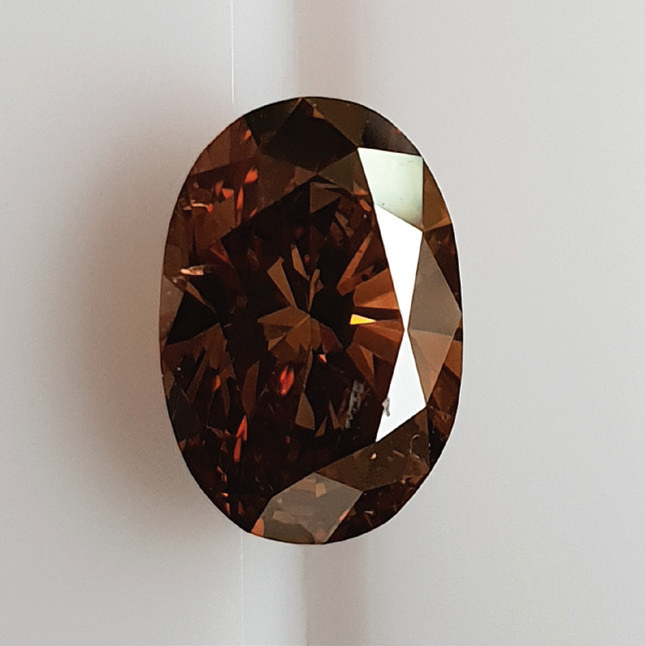 | 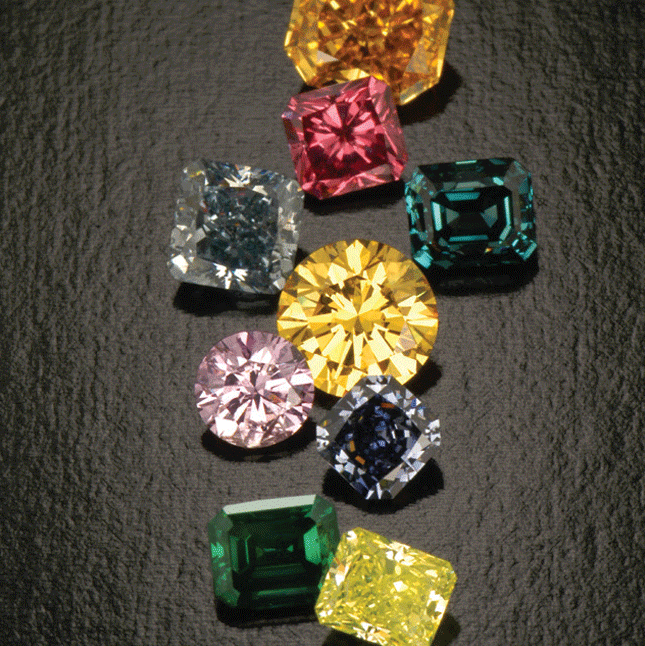 | 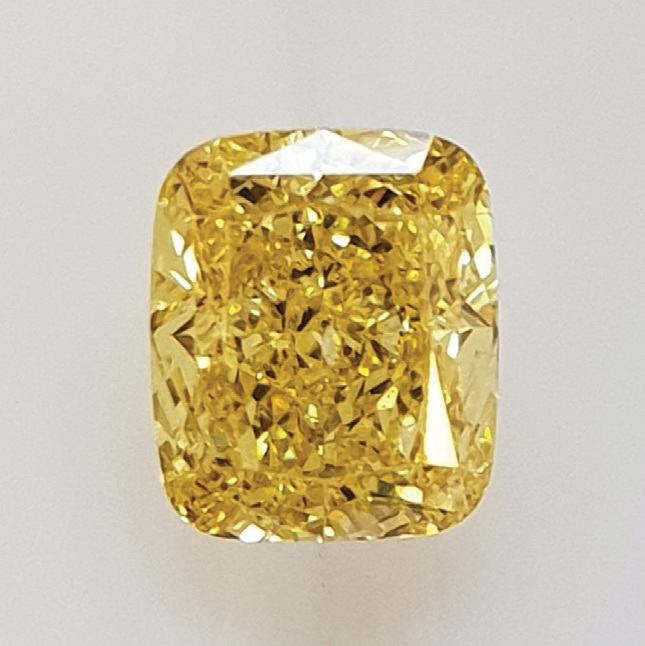 |
Above: K&K Export Import | Above: Aurora Pyramid of Hope Photo: Robert Weldon | Above: K&K Export Import |
Brave new world
Low-cost and more common colour diamonds have already proven themselves viable for jewellery; the best example is brown diamonds, which went from being ungraded on the diamond scale and used for industrial purposes, to huge popularity when re-branded as chocolate, cognac or champagne – and now even aubergine.
Google searches for ‘chocolate diamonds’ have seen huge spikes every December since 2008, implying they have a niche as a Christmas gift.
The champagne and cognac descriptors don’t achieve the same volume of searches, nor do they show the same seasonal spike – perhaps presenting an opportunity for retailers to market them as an ideal choice to ‘toast’ a big event, like the New Year, a birthday or an anniversary.
While some dismiss the ‘chocolate diamond’ as a cynical marketing campaign to sell intrinsically less-valuable stones at a premium, others see it as a way to open consumers’ eyes to the stones’ natural beauty and help them emotionally connect with the jewellery.
Bronstein is philosophical on the topic: “I’ve always believed that we should discuss the colour of a diamond as a metaphor for another natural object. This is the universal language of colour. Jewellers should feel very comfortable engaging clients in the discussion of ‘what do they see’ – encourage them to come up with a comparison from their knowledge… [and] explore options for what they can afford.”
However, Der Bedrossian is sceptical. He’s not alone; the internet is littered with headlines like: “The TRUTH about chocolate diamonds” and “Why you shouldn’t buy chocolate diamonds”.
Yet others argue that if colour diamonds are not being bought as an investment – and they shouldn’t be – and the jewellery itself is well priced for the customer’s budget, the only thing that matters is the personal connection.
“The consumer must be educated that what is beautiful to the individual does not have to meet with anyone else’s approval. Taste for beauty and colour that you connect to – whatever size, shape or beauty mark – is the right choice,” says Bronstein.
Kovacs agrees, and says the demand from consumers is definitely there: “Cognacs and champagnes that have good, true colour with no greenish overtones and high clarity have always sold well and continue to do so.”
Shifting the paradigm
In jewellery retail, as in any market, it’s crucial to look to the future and assess economic trends. It’s a familiar story: in the past few years, weak consumer confidence combined with sluggish wage growth has put downward pressure on discretionary spending – particularly on luxuries.
The question is whether retailers can adapt to flat conditions and wait it out until trade picks up – something Bronstein calls “treading water”.
“Like any industry in the world, gems and jewellery go through cycles of strong activity and weak demand. This is a normal course of business. When business slows, it gives us the opportunity to adapt and change.
“While we tread water, we are essentially preparing for the next big wave that will carry us to the next level. No one can afford to hold on to old ideas and ways of doing business. You will sink and be gone before the next ride comes around. Treading water is about building relationships and education,” Bronstein says.
So how can colour diamonds help in this process? When it comes to traditional colours, pink diamonds are still a solid option if the higher costs can be absorbed; but for some, they are offering diminishing returns and yellows offer an attractive alternative.
Further along the spectrum, champagnes, cognacs and chocolates offer more attractive margins and have at least some level of built-in marketing and consumer awareness – though Gillett cautions that many consumers now “know more than sales staff – we can thank Google for that!”
This is where Bronstein’s advice on tapping customers’ emotional connection to the gems carries the most weight.
For Neuman, education is key. “Most jewellers and consumers do not have the same understanding of coloured diamonds that they do of whites. Natural coloured diamonds are a niche, specialist field of diamonds. To gain understanding, one must have experience with them, through buying, selling and researching – working with them on a daily or weekly basis, especially where prices and availability are concerned,” he says.
He uses the analogy of car mechanics, explaining, “White diamonds represent all makes and models of cars. Natural coloured diamonds represent Tesla; while all motor mechanics understand the principles of what a car is and its components and how they go together to make the car function, they may not understand the fundamentals of how the components of a Tesla car go together and make it work. The rarer natural coloured diamonds would be Formula 1 racing cars – even more tricky and more specialised than a Tesla, and harder to get right!”
Truly, in the world of colour diamonds, there’s room for retailers at every point in the market. As Bronstein says, “When the messaging is conveyed in an honest, transparent and passionate way, there is something unique, something special, something beautiful and something affordable for anyone who would like a unique piece of the Earth.”
natural colour diamonds gallery
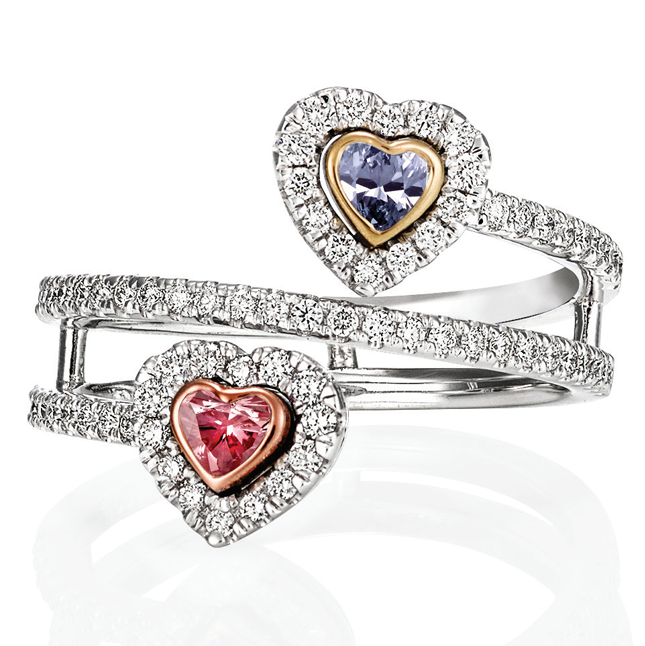 |  |
Above: Mondial Pink Diamond Atelier |
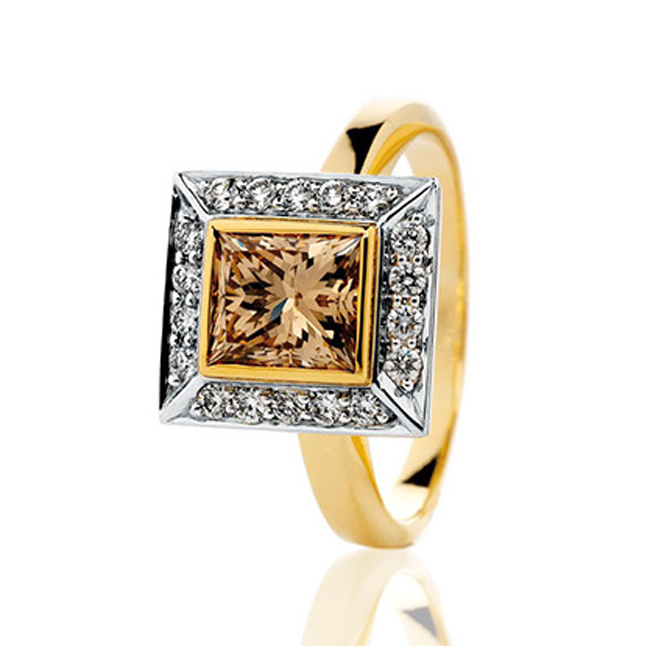 | 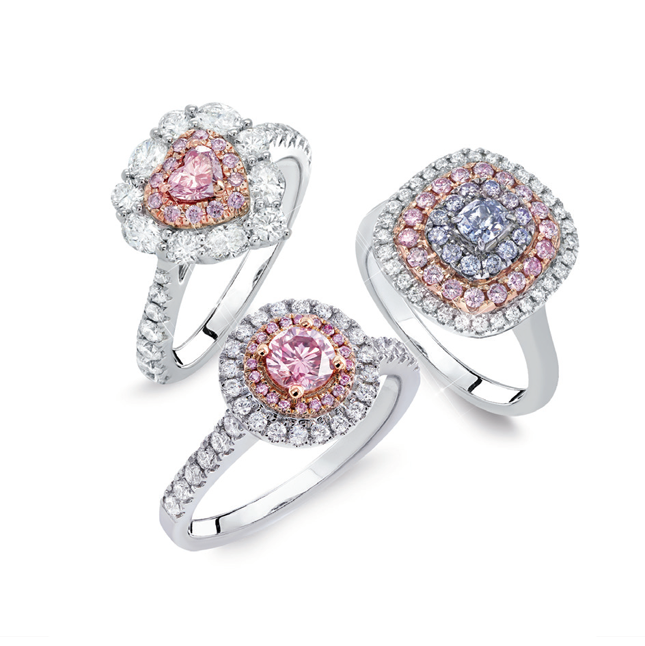 |
Above: Holloway Diamonds | Above: Sams Group Australia |